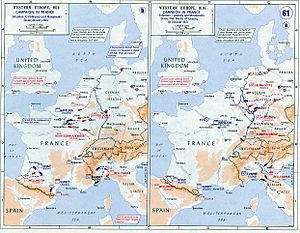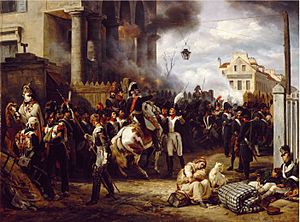Campaign in north-east France (1814) facts for kids
Quick facts for kids 1814 campaign in north-east France |
|||||||
|---|---|---|---|---|---|---|---|
| Part of the War of the Sixth Coalition | |||||||
 Click an image to load the battle. Left to right, top to bottom: Rothière, Laubressel, Laon, Arcis, Champenoise, Paris |
|||||||
|
|||||||
| Belligerents | |||||||
| Commanders and leaders | |||||||
| Strength | |||||||
| Less than 80,000 | 370,000–405,000 | ||||||
The 1814 campaign in north-east France was the last major military effort by Napoleon during the War of the Sixth Coalition. After a big defeat at Leipzig in 1813, armies from Austria, Prussia, Russia, and other German states invaded France. Even though Napoleon's forces were much smaller, he managed to win several battles. The most famous of these was the Six Days' Campaign.
However, the campaign ended in a complete loss for Napoleon. The Coalition armies kept moving towards Paris. Napoleon was not in a good position to defend the capital. Paris gave up in late March 1814. When Napoleon wanted his army to march on Paris, his top generals (called Marshals) decided to go against him. They did this to save the city from more damage. After this, the winning Coalition leaders made a deal called the Treaty of Paris. Under this treaty, Napoleon was sent away to the island of Elba. France's borders were also returned to how they were in 1792.
Contents
Why the War Started: Background
After losing battles in the Fourth and Fifth Coalitions, Prussia and Austria were forced to become allies with France. This happened during Napoleon's invasion of Russia. But this invasion ended badly for Napoleon. His huge army, the Grande Armée, was almost completely destroyed.
Seeing this chance, Prussia and Austria joined other countries to form the Sixth Coalition against France. Napoleon's army had to retreat from Russia. This led to a campaign in Germany. After some early wins, Napoleon was badly beaten at Leipzig. He had to retreat all the way back to France. Soon, most European countries turned against Napoleon and began to invade France.
The Situation in France (1814)
Once the last French troops crossed back into France, the Coalition leaders argued about what to do next. Russian Emperor Alexander I wanted to keep pushing forward. But everyone was tired of fighting. Many felt it was not smart to push Napoleon and France too hard. So, there was a long pause while the Coalition tried to make a peace deal with Napoleon.
During this time, the Coalition armies got their forces back together. Finally, they decided to follow the advice of the "Young German" group. This group was led by Blücher and other strong military leaders. They decided to attack France.
In late December 1813, three large Coalition armies began to cross the Rhine river:
- The Army of Bohemia (also called the Grand Army) had about 200,000 to 210,000 Austrian soldiers. They were led by Prince Schwarzenberg. They crossed the Rhine on December 20, 1813. They went through Switzerland, even though Switzerland was supposed to be neutral.
- The Army of Silesia had between 50,000 and 75,000 Prussian and Russian soldiers. They were led by Prince Blücher. They crossed the Rhine on January 1, 1814.
- The Army of the North had about 120,000 Prussian and Russian soldiers. They were led by Wintzingerode and Bülow. Dutch troops under Prince Bernadotte were also part of this army. This army was supposed to support the others by moving through the Netherlands and towards Laon in northern France. However, this force was not ready yet. It did not reach France until March.
To fight these armies, Napoleon needed more soldiers. He called up young men born in 1814 and 1815 to join the army. These very young and new recruits made up most of the new French Army. People nicknamed them marie-louises. This was after the young Empress Marie-Louise.
Napoleon could only gather about 200,000 men in total. More than 100,000 were fighting against the British army in Spain. Another 20,000 were guarding the Alps mountains. This meant less than 80,000 soldiers were available to defend France's eastern and northeastern borders. Even though Napoleon had fewer soldiers, he was now fighting in his own country. This meant his army could find food easily. Also, his supply lines were safe.
The 1814 Campaign Begins
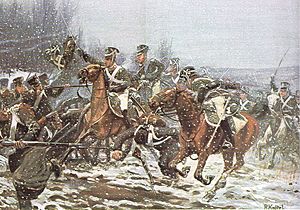
Napoleon tried to stop the Army of Silesia soon after they crossed the Rhine. But he arrived too late and had to chase them. On January 25, Blücher's army entered Nancy. They quickly moved up the Moselle valley. By the afternoon of January 28, they were in contact with the Austrian advance guard near La Rothière.
On January 29, Napoleon caught up with Blücher and attacked. Blücher's headquarters were surprised. He almost got captured by French troops during the Battle of Brienne. He also learned that Napoleon himself was nearby. So, Blücher pulled back a few miles the next morning. He found a strong position that protected the exits from the Bar-sur-Aube area. There, the Austrian advance guard joined him. Together, they decided to fight. They had no other choice, as the roads behind them were blocked with traffic.
Around noon on February 2, Napoleon attacked them in the Battle of La Rothière. The weather was terrible, and the ground was very muddy. This made his powerful artillery useless. Snowstorms swept across the battlefield, causing his troops to lose their way. Many were badly beaten by the Cossacks. When night fell, the fighting stopped. Napoleon retreated to Lesmont, and then to Troyes. Marshal Marmont stayed behind to watch the enemy.
Napoleon's Six Days' Campaign
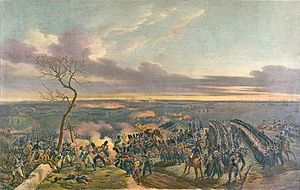
Because of the bad roads, or perhaps because Schwarzenberg's headquarters were very slow, the Coalition did not chase Napoleon. But on February 4, Blücher was annoyed by this lack of action. He got permission from his king, Frederick William III of Prussia, to move his army to the Marne valley. Pahlen's Cossack troops were given to him. Their job was to protect his left side and stay in touch with the Austrians.
Blücher thought he was safe behind this protection. He advanced from Vitry along the roads in the Marne valley. His army columns were spread out to make it easier to find food and shelter. Shelter was very important in the terrible weather. On the night of February 7/8, Blücher himself was at Sézanne. He was on the exposed side to be closer to his sources of information. The rest of his army was divided into four small groups near Épernay, Montmirail, and Étoges. More soldiers were on their way to join him and were near Vitry.
During the night, his headquarters were surprised again. Blücher learned that Napoleon himself was marching quickly to attack his scattered groups. At the same time, he heard that Pahlen's Cossacks had left two days earlier. This left his side completely open. Blücher retreated towards Étoges, trying to gather his scattered troops.
Napoleon was too fast for Blücher. He badly defeated Lieutenant General Olssufiev's Russian IX Corps at the Battle of Champaubert on February 10. This put Napoleon's army between Blücher's front troops and his main army. Napoleon then focused on the front troops. He defeated Osten-Sacken and Yorck at Montmirail on February 11. He attacked and defeated them again the next day at the Battle of Château-Thierry.
Napoleon then turned to the main part of the Army of Silesia. On February 14, he defeated Blücher in the Battle of Vauchamps near Étoges. He chased Blücher towards Vertus. These defeats forced the entire Silesian army to retreat. Napoleon left some troops with marshals Mortier and Marmont to handle them. He then rushed back to Troyes.
Napoleon, with his main army, attacked the side of Schwarzenberg's Austrian army. This army had been slowly advancing. Napoleon again caused heavy losses to his enemies at Mormant (February 17), Montereau (February 18), and Méry-sur-Seine (February 21). He hit them so hard that they quickly retreated to Bar-sur-Aube.
The Battle for Laon
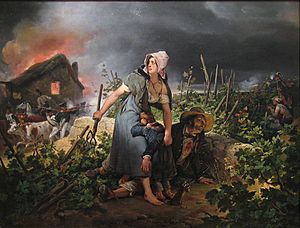
Meanwhile, Blücher had gathered his scattered forces. He was now pushing Marmont and Mortier back. As soon as Napoleon had dealt with Schwarzenberg, he marched his main army back. Moving again through Sézanne, he attacked Blücher's left side. He pushed Blücher back towards Soissons. The French soldiers guarding Soissons had given up just 24 hours before. Napoleon did not know this. Because of this, the Silesian army was able to escape. They marched north and joined Bernadotte's Army of the North at Laon. This added more than 100,000 men to Blücher's forces.
On March 7, Napoleon attacked the front part of this large force at the Battle of Craonne. He pushed them back to Laon. The Battle of Laon then took place on March 9. Napoleon was defeated here. With only 30,000 men left, he retreated to Soissons. He then heard that Reims had been captured by a Coalition army led by the Russian General Saint-Priest. Napoleon then marched past Blücher's army. On March 13, Napoleon retook Reims. General Saint-Priest was badly wounded in this battle and later died.
Arcis-sur-Aube: A Tough Fight
On March 14, Schwarzenberg learned that Napoleon was in Reims. He began to advance again. His front troops had reached Arcis-sur-Aube. Napoleon stopped them there on March 20. At the start of the Battle of Arcis-sur-Aube, the Austrians had about 21,000 soldiers. The French had 20,000. However, during the night of March 20/21, both sides received more soldiers. On the second day of the battle, the French had about 28,000 soldiers. But the Austrians now had 80,000. This difference in numbers forced Napoleon to retreat eastward. Schwarzenberg was then free to advance west.
The Coalition Marches on Paris
After six weeks of fighting, the Coalition armies had barely gained any ground. The Coalition generals still hoped to fight Napoleon with all their combined forces. However, after Arcis-sur-Aube, Napoleon realized his plan of defeating the Coalition armies one by one was not working. He decided to change his strategy.
He had two choices:
- He could retreat to Paris and hope the Coalition would agree to peace. Capturing Paris with a French army defending it would be hard and take a long time.
- He could do what the Russians did. Two years earlier, the Russians had left Moscow to him. He could leave Paris to his enemies.
Napoleon decided to move eastward to Saint-Dizier. He planned to gather any soldiers he could find there. He also wanted to encourage the people in the countryside to rise up against the invaders. He had just started this plan when a letter he wrote was found. It was sent to Empress Marie-Louise. In the letter, he explained his plan to attack the Coalition's supply lines. Cossacks in Blücher's army found this letter on March 22. This meant his plans were now known to his enemies.
The Coalition commanders held a meeting at Pougy on March 23. At first, they decided to follow Napoleon. But the next day, Tsar Alexander I of Russia and King Frederick William III of Prussia, along with their advisors, thought about it again. They realized how weak Napoleon was. They also worried that the British army from Toulouse might reach Paris first. So, they decided to march straight to Paris. Paris was an open city, meaning it had no strong defenses. They would let Napoleon do his worst to their supply lines.
The Coalition armies marched directly to the capital. Marshals Marmont and Mortier gathered what troops they could. They took up positions on the Montmartre heights to fight the Coalition. The Battle of Paris ended when the French commanders saw that fighting more was useless. They surrendered the city on March 31. Just as this happened, Napoleon, with the remains of his best troops, was rushing towards Fontainebleau to join them.
What Happened Next: Aftermath
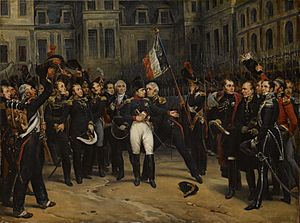
On April 2, the French Senate agreed to the Coalition's terms. They passed a rule removing Napoleon from power. They also issued a statement on April 5, explaining why they did this. Napoleon was not in a position to defend Paris. He had only reached Fontainebleau when he learned that Paris had surrendered. When Napoleon suggested the army march on the capital, his generals decided to go against him. They did this to save Paris from being destroyed.
On April 4, Napoleon gave up his power in favor of his son. His wife, Marie-Louise, would rule as regent. However, the Coalition refused to accept this. Napoleon was then forced to announce his complete surrender just two days later. He signed the Treaty of Fontainebleau.
Napoleon was sent away to live on the island of Elba. The monarchy was brought back, with Louis XVIII becoming king. The Treaty of Paris was signed on May 30, 1814. It was signed by representatives of the French monarchy and the Coalition powers. This treaty officially ended the War of the Sixth Coalition. It returned France to its borders from 1792, before the Congress of Vienna meeting. Napoleon escaped from Elba the next year, which led to the Hundred Days period. He was finally defeated at Waterloo by the Seventh Coalition.


